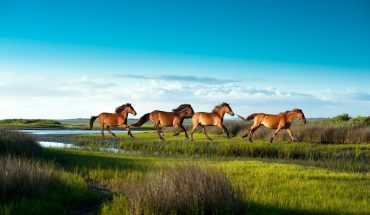
by Addie Ladner
photographs by Bert VanderVeen
“It’s like a cooking show in here,” says sculptor and blacksmith Mike Waller. He’s meticulously inserting and removing a small slab of carbon steel in and out of a 2,200-degree forge in his cinder block studio, which was once was an old country store. His studio sits behind the idyllic Hillsborough farmhouse he shares with his wife, Leah, two young children Neva, 5, and Herbert, 4, their dog, and a few chickens. The piece of carbon steel will soon transform into a handcrafted oyster knife that blends art and functionality: a Carolina Shucker.
He moves quickly and steadily, shaping and pounding the now neon-orange rod again and again to make the oyster knife’s blade, then its handle. Waller can make more than 100 of these oyster knives in just over a day, and he does it seemingly effortlessly. The oyster knife he’s making on this particular day started out as a basic slab of steel, but old rusty North Carolina railroad spikes are what he most prefers to use, he says. Railroad spikes have a sense of place and give each knife character. “The older the better, then they’re all different and come with history and a story,” he says.
Those story-imbued, historic railroad spikes—plus carbon steel and the occasional horseshoe—have come to hold high value to Waller and his lifelong friend Kirk Davis. The two grew up together in Kinston, North Carolina, and both received Bachelor of Fine Arts degrees in sculpture from East Carolina University. Now, the friends together have carved a niche locally and countrywide for their artisan oyster knives, Carolina Shuckers. The shuckers pay homage to their Eastern North Carolina upbringing, they say, and are a tribute to the rich history and traditions of the state’s coastal culture.

Davis, who lives and runs his own studio, ArtForms, in Morehead City, specializes in metal, iron, and woodworking. Waller runs WallerFoushee Studios with his wife Leah; his work can be seen in public spaces all over the Triangle, most notably the iconic, larger-than-life, 2,000-pound bronze bull in downtown Durham, Major. (Waller and then-girlfriend Leah made the bull together over the course of 13 months while working for a metal shop Durham. “We had never done anything like that in our life ever,” he says of the project.)
In 2009, Davis, Waller, and a few other friends found themselves at an oyster roast, but short on oyster knives. “We thought it was crazy that we were metalworkers and no one had oyster knives,” says Waller. So after the roast, Waller and Davis each went back to their own shops to take a stab at making a few knives for the next roast. Their creations were a hit: Friends at the next oyster roast wanted the knives for themselves, their friends, friends of friends, and so on. “It was all very grassroots,” Davis says. “At the time no one was making oyster knives, and we didn’t know what a hand-forged oyster knife should look like. But we started selling them quickly, calls kept coming in, and we knew we were on to something.”
The duo’s whim of a project quickly turned into a thriving side business, including special commissions from the likes of acclaimed chef Vivian Howard’s Kinston restaurant, The Boiler Room, and Kiawah Island Golf Resort, a luxury getaway in South Carolina. Each shucker was vastly different than the others, but the originality and quality appealed to customers. “We’d take all this metal and were repurposing wrought-iron handrails. We’d make a smaller knife, then a larger one, and we’d add twists to the handles,” Davis says of the early experimentation process. Eventually, thanks to feedback from their friends, the two settled into eight different knife designs—this preserves originality by offering choices, they say, but has helped them streamline the design process. “We wanted a complete set,” Waller says. Plus, “everyone shucks an oyster differently.” Some folks start at the hinge, he says, others at the mouth. Some hold their fingers up close on the blade of the oyster knife, while others the handle.

The streamlining has paid off. Now, Davis and Waller make between 5,000 and 10,000 knives a year, sold in more than 20 shops around the country as well as the Carolina Shuckers online shop. The knives are all made from salvaged railroad spikes, carbon steel, and horseshoes. While they’ve simplified the design process, they have not sacrificed the attention to detail: Each shucker is individually made by one of the two artists, divvied up between their two studios. Waller makes the Mamas Boy, the Ole Big Boy, the Queen Anne, and the L’il Big Boy in Hillsborough, about an hour northwest of Raleigh; the Mother Shucker, the Shuggie Shucker, the Half Peck, and the Cluster Shucker are Davis’ handicraft in Morehead City. “We continue to sell even when it’s not oyster season,” Davis says.
A Carolina Shucker has heft: each weighs around one pound, which is significantly heavier (and sturdier) than the typical white-plastic-handled Dexter Russell oyster knife. “We wanted to make oyster knives like they used to use long ago, that your grandfather would have been using and share some of our Southern culture and history,” says Waller. Waller says after he and Davis stumbled into making the knives for that first casual roast, they discovered this heritage of oyster knives from people on the coast. There, knives’ appearance vary by place and come with their own stories. “Down East, they have knives made out of all kinds of things, like paint scrapers, screwdrivers, files, and bolts—anything that was hard steel,” Waller says. The notion of “family, handmade, heirloom oyster knives” resonated, “but since we’re artists we also wanted (to make) something new and original and funky.”

Some of the originality can be found in the knives’ names. The Queen Anne knife was inspired by Queen Anne’s Revenge and mimics a sailboat. Its look is feminine, long, and lean. The Mother Shucker is the “mother of all oyster knives,” Waller says, and the largest in the collection. The Cluster Shucker, a sleek, simple knife, looks very similar to the railroad spike from which it’s made. The Shuggie Shucker is named after the common Southern greeting Hey Shug.
Several styles have a twisted handle to mimic a wave in the ocean, while other handles resemble crocodile skin. And since, according to Davis, “an oyster roast and drinking beer go hand and hand,” they eventually decided to add a bottle opener to many of the styles.
As for how Waller himself shucks the salty, slippery bivalve? “Wiggle. Wiggle. Twist. Go for the hinge,” he says. And while the sale of Carolina Shuckers across the country has allowed the friends to try oysters from British Columbia to Portland, Oregon to San Francisco, Waller’s preference remains Stump Creek or Taylors Creek from here in North Carolina. “Wild is better,” he says, and he has just the tool to match them.



